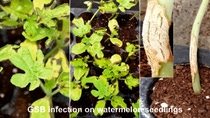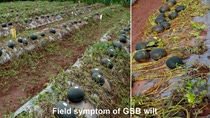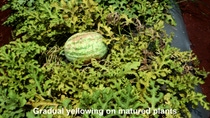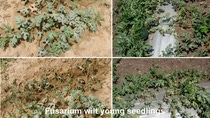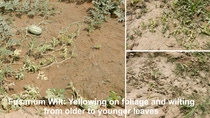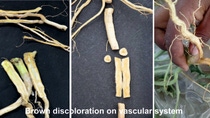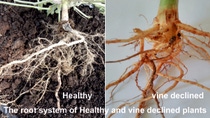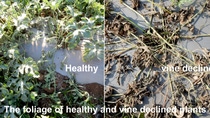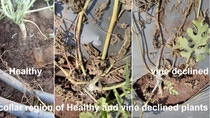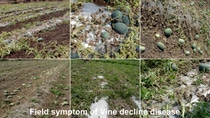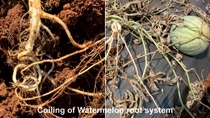Watermelon Disease Management
Fusarium Wilt of Watermelon
Disease and Pathogen
A wide range of wilt symptoms viz damping off, collar rot, gradual wilt, gummy stem blight and sudden progressive wilt of older plants occurs on watermelon, which can make diagnosis difficult until unless monitor the field regular basis. Fusarium wilt of watermelon is one of the most serious and difficult diseases to manage.
Fusarium wilt of watermelon is caused by the fungus Fusarium oxysporum f. sp. niveum (FON). The pathogen is host-specific to watermelon and will not cause disease on other closely related cucurbits or non-cucurbit hosts. Four races, designated 0, 1, 2, and 3, have been described, race 2 is emerging in many watermelon growing regions in northern and central India. Other Fusarium species Fusarium solani f. sp. cucurbitae are responsible for crown and foot rot in other cucurbits also caused wilt in watermelon. The spread of crown and foot rot is very limited in India.
Identification
The Fusarium fungus infect all the stages of watermelon seedling, so the wilt can expect any crop stages. The first field symptoms of Fusarium wilt of watermelon plants are dull gray-green leaves and wilting during the hottest part of the day. Wilted plants commonly recover at night, but over time (2 to 5 days) wilt symptoms become permanent. The gradual yellowing of leaves is one of the prominent symptoms in the matured plants. Wilt symptoms may appear on one or more runners. Infected plants eventually collapse and die. The spatial distribution of infected plants in the field often appears as clusters. Brown-to-reddish discoloration of the vascular tissues in the plant crown and runners is diagnostic for this disease. Plant roots may appear white and healthy early in the infection. However, in later stages of the disease, the entire root may become dark brown, and a soft rot may develop near the crown. Infected seedlings in transplant houses may rapidly wilt and die without exhibiting the typical vascular discoloration.
Favorable environmental conditions for the disease
Fusarium infects in the cool and wet weather when the plants are young and overtakes the vasculature. Hot and dry summer temperatures can stress the plant and cause the wilting symptoms that are typical for the disease.
Similar Diseases
Verticillium wilt of watermelon caused by Verticillium dahliae has similar symptoms to Fusarium wilt of watermelon. These two diseases both present unilateral wilting and cannot be distinguished in the field. Both diseases also cause the same dark brown staining of the vascular tissue. The causal agent must be isolated from the infected tissue to discern which pathogen is causing the disease.
Bacterial wilt of watermelon also exhibits wilting that begins in only a few leaves. This disease is caused by the bacterium Erwinia tracheifila. When the stem is cut, a white bacterial ooze will often come out of the stem, which does not happen in Fusarium wilt.
Management
The wilt in watermelon can be managed by a combination of cultural, biological, and chemical strategies.
Before Planting:
- After previous crop production (any cucurbits), remove all plant debris from the field and bury or compost it. Soil pathogens like Fusarium persists longer in debris left on the soil surface compared to those that are buried. This pathogen can survive for at least 2 years in dried, infected stems/roots left on the soil surface. Such undecomposed crop residue becomes a source of airborne spores when it is wetted. The new inoculum can be released 3-4 hours after wetting of infected plant material from the previous season.
- Maintain soil structure using green manure crops, applying farm yard manures and other measures. Compacted soils with poor structure, poor drainage and low aeration favour soil-borne pathogens.
- When preparing hills for beds with plastic mulch, ensure soil depth and drainage is adequate.
- Use white, reflective plastic mulch instead of black mulch during hot weather.
During Planting:
- Select healthy and quality seeds.
- Direct sowing: Don’t sow new seeds adjacent to old watermelon fields
- Transplanting the seedlings from nursery: Check for leaf spots on the seedling. If there is one or two plants showing spot, remove the symptomatic seedling and drench the seedling with fungicide before transplanting. If there are many spots, do not use any of the seedlings.
- Do not plant oversized, root-bound seedlings as deep planting predisposes plants to sudden wilt.
During Growth:
- After planting, check the seedlings at least twice a week. If spots are seen on the leaves, remove them to delay the spread of the disease.
- Use irrigation scheduling to ensure plants are neither over-watered (which causes waterlogging and low oxygen levels), nor stressed through under-watering. Avoid over-watering, particularly at fruit set. Avoid the irrigation in day hot conditions.
- The fungus colonizes the roots immediately after transplanting (first few weeks) and wait to be fruiting stage to develop the wilt. So regular drenching of fungicides in first few weeks reduce the wilt diseases.
- After harvest:
- Collect and burn the debris as soon as the harvest has finished.
- Do not plant watermelons in the same land as the last crop. Leave a break for at least one or two seasons. The fungus can survive in the soil, living on plant remains. Rotate with other crops like pulses and grains but not with crops in the cucurbit family, such as bottle gourd, melon, cucumber and pumpkin.
Gummy Stem Blight of Watermelon
Disease and Pathogen
On watermelon, the GSB is mainly confined to foliar disease although wilt is occurred to due to collapse of vines. This disease often causes total crop loss. It is caused by Stagonosporopsis cucurbitacearum; (previously, Didymella bryoniae). Association of few of the Phoma species also reported in watermelon.
Identification
A wide range of foliar symptoms occurs on watermelon, which can make diagnosis difficult. Predominant early symptom consists of a pale yellow or brown dead tissue, often with a yellow halo, extending backwards in a V-shape. Sometimes the entire margin is affected, creating a brown edge. Lesions may also appear entire leaves consist of circular to irregular in shape large and spots surrounded by a yellow halo and when spots dry up, they often crack. Heavily spotted leaves are collapsed and leads to defoliation.
In stem, the early symptom consists of pale brown lesion on the main stem close to collar regions. The lesions become dotted and almost entirely covered with pin head size tiny black spores. The crack may also happen and exude a gummy amber-coloured sap leads to wilting of vines and plant death will result.
Favorable Environmental Conditions for Disease
Gummy stem blight develops in humid conditions and continuous wetness on leaf surfaces. The most significant contributor to establishing the infection is how long plant surfaces remain wet. So, it is very important to control the disease when first seen, otherwise it spreads very quickly, especially during days of heavy and continuous rain. So continuously look for the rapid development of black spots and blotches that are typical of this disease in the field, especially during wet weather.
Management
The wilt in watermelon can be managed by a combination of cultural, biological, and chemical strategies.
Before planting:
- After previous crop production (any cucurbits), remove all plant debris from the field and bury or compost it. Soil pathogens like Fusarium persists longer in debris left on the soil surface compared to those that are buried. This pathogen can survive for at least 2 years in dried, infected stems/roots left on the soil surface. Such undecomposed crop residue becomes a source of airborne spores when it is wetted. The new inoculum can be released 3-4 hours after wetting of infected plant material from the previous season.
- Maintain soil structure using green manure crops, applying farm yard manures and other measures. Compacted soils with poor structure, poor drainage and low aeration favour soil-borne pathogens.
- When preparing hills for beds with plastic mulch, ensure soil depth and drainage is adequate.
- Use white, reflective plastic mulch instead of black mulch during hot weather.
During Planting:
- Select healthy and quality seeds.
- Direct sowing: Don’t sow new seeds adjacent to old watermelon fields
- Transplanting the seedlings from nursery: Check for leaf spots on the seedling. If there is one or two plants showing spot, remove the symptomatic seedling and drench the seedling with fungicide before transplanting. If there are many spots, do not use any of the seedlings.
- Do not plant oversized, root-bound seedlings as deep planting predisposes plants to sudden wilt.
During Growth:
- After planting, check the seedlings at least twice a week. If spots are seen on the leaves, remove them to delay the spread of the disease.
- Use irrigation scheduling to ensure plants are neither over-watered (which causes waterlogging and low oxygen levels), nor stressed through under-watering. Avoid over-watering, particularly at fruit set. Avoid the irrigation in day hot conditions.
- The fungus colonizes the roots immediately after transplanting (first few weeks) and wait to be fruiting stage to develop the wilt. So regular drenching of fungicides in first few weeks reduce the wilt diseases.
After Harvest:
- Collect and burn the debris as soon as the harvest has finished.
- Do not plant watermelons in the same land as the last crop. Leave a break for at least one or two seasons. The fungus can survive in the soil, living on plant remains. Rotate with other crops like pulses and grains but not with crops in the cucurbit family, such as bottle gourd, melon, cucumber and pumpkin.
Vine Decline and Sudden Wilt
Disease and Pathogen
Vine decline is a major problem on watermelons in southern and central India during hot, dry weather when crops are grown in plastic mulch which results is soil temperature is very high.
The precise cause of vine decline in watermelon in India has not been fully determined. Although several pathogens have been isolated from the roots of vine declined plants, the disease is complex. It is combination of growing conditions, plant architecture and physiology of plant during fruit maturation. The infection of any soil pathogen (viz Pythium, Fusarium, Macrophomina) further leads to disease is severe.
Identifications
Symptoms of vine decline begin to appear approximately 2 weeks before fruit maturity. The disease may appear initially as yellowing of foliage close to collar regions, followed by a slow decline in plant health by wilting. In some cases, a collapse of vines may occur with no other symptoms. Vascular tissue (phloem) from crowns of affected plants is often discolored, appearing light brown rather than a healthy translucent green. The rapid wilt of plants may result in complete death in less than a week, leaving most of the crop immature and resulting in total crop loss. On symptomatic plants, the root systems are generally sparse — the primary roots are necrotic (dead tissue), and the plant has few secondary roots
Favorable Environmental Conditions for Disease
The vine decline incidence is quite high in mini watermelons (2-3 fruits per plant) compared with Jubilee watermelon (one fruit per plant). The high demand for water during fruit enlargement cannot be met due to shallow roots and or too small vines. Lots of moisture during plant establishment leads to infection of lower fungus.
Management
There are no effective control measures available that that provides adequate control of the vine decline disease. By avoiding the factors contributing to vine decline can reduce the wilt in the plant.
Before Planting:
After previous crop production (any cucurbits), remove all plant debris from the field and bury or compost it. Soil pathogens persists longer in debris left on the soil surface compared to those that are buried. This pathogen can survive for at least 2 years in dried, infected stems/roots left on the soil surface. Such undecomposed crop residue becomes a source of airborne spores when it is wetted. The new inoculum can be released 3-4 hours after wetting of infected plant material from the previous season.
Maintain soil structure using green manure crops, applying farmyard manures and other measures. Compacted soils with poor structure, poor drainage, and low aeration favor soil-borne pathogens.
When preparing hills for beds with plastic mulch, ensure soil depth and drainage is adequate.
Use white, reflective plastic mulch instead of black mulch during hot weather.
During Planting:
- Select healthy and quality seeds.
- Direct sowing: Don’t sow new seeds adjacent to old watermelon fields
- Transplanting the seedlings from nursery: Check for leaf spots on the seedling. If there is one or two plants showing spot, remove the symptomatic seedling and drench the seedling with fungicide before transplanting. If there are many spots, do not use any of the seedlings.
- Do not plant oversized, root-bound seedlings as deep planting predisposes plants to sudden wilt.
- Drench the fields with fungicides before transplanting.
During Growth:
- After planting, check the seedlings at least twice a week. If spots are seen on the leaves, remove them to delay the spread of the disease.
- Use irrigation scheduling to ensure plants are neither over-watered (which causes waterlogging and low oxygen levels), nor stressed through under-watering. Avoid over-watering, particularly at fruit set. Avoid the irrigation in day hot conditions.
- The fungus colonizes the roots immediately after transplanting (first few weeks) and wait to be fruiting stage to develop the wilt. So regular drenching of fungicides in first few weeks reduce the wilt diseases.
After Harvest:
- Collect and burn the debris as soon as the harvest has finished.
- Do not plant watermelons in the same land as the last crop. Leave a break for at least one or two seasons. The fungus can survive in the soil, living on plant remains. Rotate with other crops like pulses and grains but not with crops in the cucurbit family, such as bottle gourd, melon, cucumber and pumpkin.
Watermenlon Bud Necrosis Disease
Pathogen: Watermelon bud necrosis virus (WBNV)- Orthotospovirus
Watermelon bud necrosis disease was first found in India in 1991-92, ever since sporadic outbreaks of this disease have occurred all major watermelon growing regions. So, it was regarded as one of the serious diseases in watermelon crops in across India. The disease was shown to be caused by a virus named Watermelon bud necrosis virus (WBNV). This virus is transmitted by a tiny, slender insects (less than 2 mm long) called ‘thrips’ and widespread across India. Thrips feed on flowers and leaves of plants using piercing and sucking mouthparts.
Symptom
WBNV causes a range of symptoms, include chlorotic-, necrotic-, ringspots, line patterns, mottling, and chlorotic blotches on leaves. Early infection leads to stunted growth with narrowed leaf laminae, shorter internodes, tip necrosis and dieback. Both leaves and fruit are often distorted with dark spots or ring patterns on fruit. Fruit set was drastically reduced. Symptoms are influenced by the age of the plants, variety, weather conditions and nutritional state.
While walking through the field, look for the upright growth of younger branches with chlorotic to necrotic spots. Necrosis on the buds and stems. Necrotic rings and blister on the fruit surface.
Look alike diseases: Aphids transmitted Papaya ring spot virus-W type also produces chlorotic, mosaic symptom on foliage and blister, concentric rings on the fruits surface.
Disease Transmission
WBNV is transmitted by thrips. Orthotospoviruses are not transmitted by other sap sucking insects such as aphids, leafhoppers or chewing insects, e.g. beetles. Tospoviruses are not spread in seed or on cutting, pruning and cultivation equipment. The viruses are not spread by handling plants and do not survive in soil or decaying crop residues.
Management
The first line of defense against any disease is producing healthy plants and growing them in an environment that is as free of the virus and its vector (thrips) as possible. Viruses cannot be cured-only prevented.
Before Planting:
- Select the suitable sowing windows, which can avoid periods of high thrips populations in the younger crops
- Reflective mulch can delay or reduce the extent to which young plants become infested by thrips and other sucking pests. Silver is the most effective color for synthetic reflective mulch against thrips
- Check seedlings to ensure that they are free from symptom of thrips infestation. It is best for farmers to source seedlings only from nurseries that are grown with thrips-grade mesh.
- If possible, spray or drench with insecticides before transferring the seedling trays from nursery to field.
- Thrips species that feed on many different plant species often move rapidly from one field to others. So, remove weeds from within and around crops.
- Border crops:A 1meter strip around the field following a row crops (viz corn) with green shade net reduce the thrips movement. The row crops need to sow at least 2-3 weeks earlier than watermelon transplanting.
- Do not plant new crops next to the old watermelon crops. This is very important if the “old” crop is infected with virus and thrips.
During Growth:
- Apply row covers before crops emerge or to pest-free plants during planting. Plants are normally covered or caged only while they are young and most susceptible to damage. Once plants become larger or temperatures get warmer, remove covers to provide enough growing space and to prevent overheating. Drip or furrow irrigation is generally necessary when using row covers.
- Monitor routinely for thrips. Use yellow or blue sticky traps placed about 10 cm above the crop and inspect weekly.
- Rogue any plants showing symptoms of virus to avoid the faster spreading.
After Harvest:
- Collect and destroy crop debris by burying or burning.
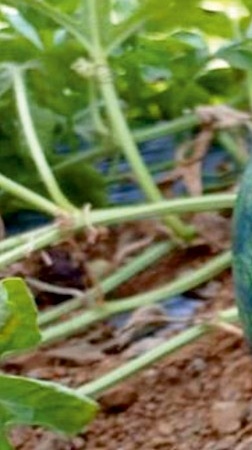
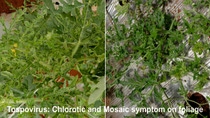
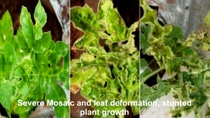


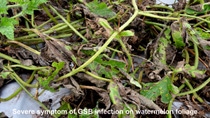

%20formation%20on%20watermelon%20leaf%20and%20petiole.jpg)
